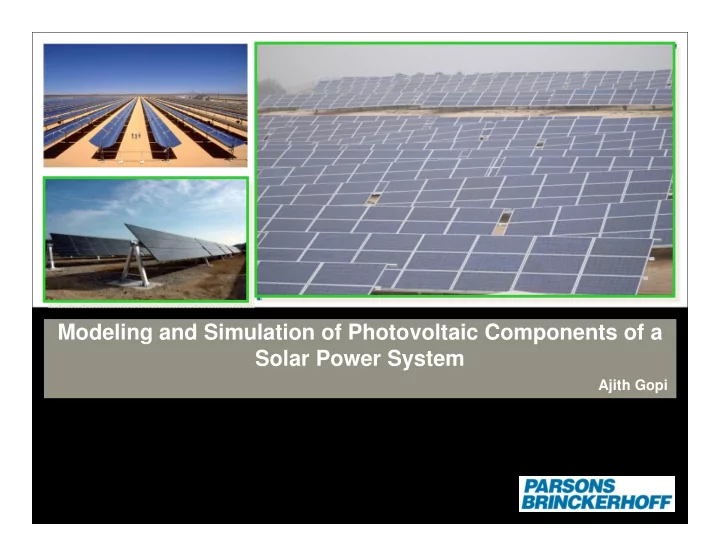

Modeling and Simulation of Photovoltaic Components of a Solar Power System Ajith Gopi
Parsons Brinckerhoff • Parson Brinckerhoff – >14,000 people – 150 offices – six continents • PB Power Asia – 500 people – Most major Asian cities – Asia-Pacific region since early 1990s – Engineering Support for solar and wind power development
Recent Solar PV Modeling Experiences • LE’s Technical Advisor for Multiple Solar PV Projects in China (25.5MW) • Technical Due Diligence of PV Projects (20MW) in Portugal for a client in Korea • LE for 25 MW Solar PV project in Gujarat in India
Contents
PV Cell Model The output current from the PV cell can be found using the equation: I=I sc -I d (Where I sc is the short-circuit current that is equal to the photon generated current, and I d is the current shunted through the diode) The diode current is given by the Schottky diode equation: I d = I 0 * (e q*Vd/(k*T) -1) (Where I sc is the reverse saturation current of the diode (A), q is the electron charge (1.602 x 10 -19 C), Vd is the voltage across the diode (V), k is the Boltzmann’s constant (1.381x10 -23 J/K) and T is the junction temperature in Kelvin (K))
PV Cell Model (…continued) Combining the diode current equation with the equation for the output current of the PV cell creates: I= I sc- I 0 * (e q*V/(k*T) -1) (Where V is the voltage across the PV cell, and I is the output current) We can solve for the reverse saturation current (I 0 ) by setting I=0 (no output current). I 0 = I sc (e q*Vd/(k*T) -1)
More accurate model of a PV Cell Taking into account the series Resistance, Shunt Resistance and Recombinations, the equation becomes: I= I sc – I 01 * (e q*V+I*Rs /(k*T) -1) – I 02 * (e q*V+I*Rs /(2*k*T) -1)- (V+I*Rs)/Rp The two diodes can be combined to simplify the equation to: I= I sc – I 0 * (e q*V+I*Rs /(n* k*T) -1) - (V+I*Rs)/Rp (Where n is known as the “ideality factor” and takes a value between one and two)
Model of a PV Cell The effect of the shunt resistance is minimal for a small number of modules. Therefore, we can assume Rp= ∞ ∞ , simplifying the photon-generated ∞ ∞ current equation to: I= I sc – I 0 * (e q*(V+I*Rs /(n*k*T) -1)
Simulink - PV Cell Model
PV Cell Model I-V and Power Characteristics
Simulink Implementation of PV Module PV Modules are implemented as Masked Subsystems in Simulink in two Input modes • Current Input PV • Voltage Input PV Module Module
Model parameters for the Simulink Model Model parameters, in both cases, are the standard PV module data-sheet parameters: • Short-circuit current Isc • Open-circuit voltage Voc • Rated current Ir at maximum power point (MPP) • Rated voltage Vr at MPP (Under standard test conditions of 1kW/m2, 1.5 AM, 25 o C).
Simulink Implementation of a Current Input PV Module Inputs: • PV current Ipv [A] • Insolation [W/m2] Outputs: • PV voltage Vpv [V] • PV output power Ppv [W] This model is well suited for the case when modules are connected in series and share the same current
Simulink PV Module Model
Simulink PV Module Model Sub System with Current Input (I pv )
Simulink Implementation of a Current Input PV Module Inputs: • PV voltage Vpv [V] • Insolation [W/m2] Outputs: • PV current Ipv [A] • PV output power Ppv [W] This model is well suited for the case when modules are connected in parallel and share the same voltage
PV Module Sub System with Voltage Input ( Vpv) (Suitable for Parallel Connections)
Simulink PV Module Model as a Software Tool for Performance Analysis
PV Module Model – I-V and Power Characteristics
Performance Comparison two PV Modules Data Sheet Parameters of Data Sheet Parameters of Module A Module B Isc 2.5 A Isc 2.5 A Voc 21.8 V Voc 21 V Imp 2.3 A Imp 2.18 A Vmp 17.3 V Vmp 17 V Power at S.T.C 40 W Power at S.T.C 40 W
I V Characteristics comparison and validating with PV Syst values Fill Factor is more for Module A since the squareness of the curves is more for Module A. Hence Module A is more efficient than Module B
Power Characteristics Comparison odf Module A & B Fill Factor is directly proportional to the Power output of the PV Module Hence it is evident that output power of Module A more compared to Module B
Simulink – PV Array Model (WITH SOLAR MODULE MODEL SUBSYSTEM BLOCK WITH CURRENT (Ipv) INPUT)
Conclusions • Photovoltaic components of a Solar Power System are mathematically modelled and then simulated in Matlab/Simulink. • Simulink models are implemented for: Solar Cell, PV Module (Current Input Model and Voltage Input Model) & a typical Solar Array • Development of a Software tool for the PV Module Performance Evaluation from the Module Data Sheet Parameters.
Any Questions? Thank you for your attention! Further information please contact: Ajith Gopi Principal Engineer gopi.ajith@pbworld.com
Recommend
More recommend